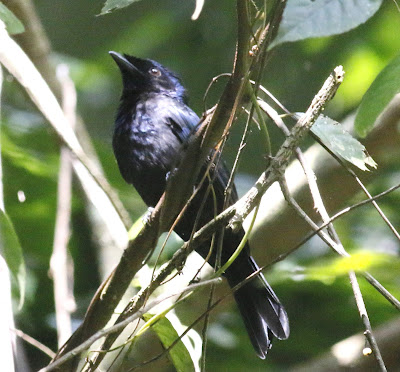Genting Highlands is already well known for its theme parks and hotels (both locally and internationally). However not many people may realise that this place also offers a variety of birds and avifauna which can be mesmerizing. Here are some of the birds which can be seen at this highland and from the photos depicted here, you can roughly guess which part of the highlands that they have came from.
 |
| Snowy-browed Flycatcher (female) |
 |
| Mountain Leaf Warbler |
 |
| Bar-Throated Minla |
Bet you can't find this bird in Penang Hill.
 |
| Mountain Bulbul |
Quite a stunning looking bird but unfortunately there is nothing melodious about its calls.
 |
| Long-Tailed Sibia |
This Long Tailed Sibia could have been a sub-adult cause its eyes is not quite that reddish yet.
 |
| Pacific Swallow |
Pacific Swallow Jr
The above juvenile Pacific Swallow was seen fed by the above adult bird. This time i saw quite a number juvenile fledglings of other bird species too. You can see more of them in later photos. Its Kids Power this time !
 |
| Mountain Tailorbird |
Tailorbirds as some of you may have known are the host brood for some cuckoo birds. However i am not sure whether this fluffy looking Mountain Tailor is a host to any cuckoo birds at 1700 meters asl.
This pitcher plant or more commonly called monkey cup, believe it or not is a collector's item ! Luckily it was located at a very steep cliff for any poachers to get their hands on it. One slip he/she can go right down to visit Gollum or Mr Sauron in the Middle Earth and kiss goodbye to their mountain adventures.
 |
| Malayan Laughing Thrush |
 |
| Chestnut-Capped Laughing Thrush |
After feeding their young ones its time to fill up their own stomach. Looks like it had just caught a Hawk moth.
 |
| Large Niltava - male |
 |
| Large Niltava - female |
 |
| Large Niltava - sub adult |
Could this be a Small Niltava?
The above squirrel was probably the one which was making all the weird sounds inside the bush. This time it has decided to come out to forage for food.
Get out of my way ! No you get out of my way !
 |
| Streaked Wren Babbler |
This Wren certainly don't need further introduction. Although it is said to be common but you can't see it all the time let alone coming out to forage just a few feet away from where i stood !
I was also lucky this time to see another of its species which is not so common as the above Wren.
 |
| Pygmy Wren Babbler - dark morph |
From the above photos you can see the differences between the two Wrens. One has spots on its wings and scale like feather on its back while the other Wren is more brownish and smaller in size etc etc. As you may know, Pygmy Wren Babblers have actually two morphs. The nominated and more common ones are the pale morph while the not so common ones are the dark morph ! Both the above Wrens were so human friendly and tame that i could have fed them with my hands !
Here is another mega star !
 |
| Red-Headed Trogon - female |
Besides pitas and hornbills, any sightings of trogons will usually be considered a priceless encounter. Glad that Malaysia do have quite a number of its very own unique species of trogons.
 |
| Orange-bellied Leafbird |
 |
| Bronze Drongo |
 |
| Yellow-Bellied Warbler |
More photos and stories to be continued in part II
Happy Birding !






























